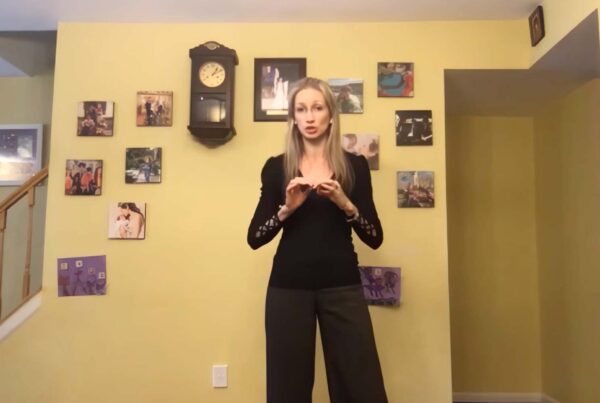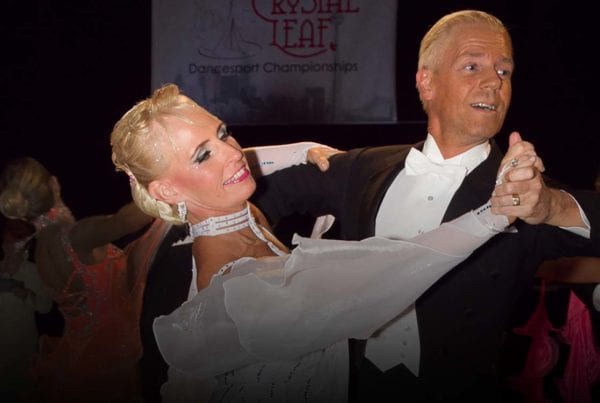Pretty well all music for dancing is phrased, and we use this phrasing to enhance the quality of our dancing and choreography. This is discussed in more detail in my post on musicality. Waltz also has phrasing, yet many people ignore it or don’t understand it. Using it effectively can dramatically improve the way you dance. Here’s how to dance a conversational Waltz.
The Modern Waltz uses 3/4 timing, or three beats to every bar of music. Many dancers think of the Waltz as consisting entirely of 1-2-3 counts of music but when you really listen closely to the music you will actually hear a clear 1-2-3 4-5-6 beat value.
Furthermore, the Waltz is slow enough that the timing of the music relates well to the way we naturally breathe. On average, while awake we breathe in and out about 30 times per minute — 15 breaths in and 15 out. The Waltz has a tempo of 28-30 bars per minute, pretty much a perfect match. Breathing in and out is a natural sequence that you don’t even think about because you’ve been doing that your whole life. I’ll address the issue of breathing through your dancing in a different post, but we’ll take a look at how this natural timing of 1-2-3 and then 4-5-6 can be optimized in how you dance the Waltz.
On average, while awake we breathe in and out about 30 times per minute. The Waltz has a tempo of 28-30 bars per minute, pretty much a perfect match.
In Waltz music, the first bar of music (the first three beats) are heavier, while the second three beats are softer. We think of this as a question followed by the answer. It makes sense, because the heavier beats lend themselves to the idea of a question while the softer beats match the idea of a gentle answer.
The Waltz is perfectly suited to the visualization of a man and lady strolling through a park having a conversation. Although this concept of a conversation can apply to all the Standard dances and even some Latin dances, it is especially relevant to the Waltz because of its tempo. The man asks a question. The lady answers. He asks another and the lady responds with her next answer. A conversational Waltz reflects this natural human interplay.
Picture a couple on a date. Questions and answers are a natural process that happen during that experience; a time of connecting and getting to know one another. Of course, in everyday life the lady will ask as many questions as the man (probably more), but in dance we have lead and follow so we need to keep things organized around that or we lose control of the dance.
Every step pattern in the Waltz follows this typical sequence. In the Natural Turn, for example, the man asks the question as he swings forward in the first half of the turn. When the lady moves forward for the second half of the figure, she is responding to his question. In a Whisk and Chasse, the man asks the question during the Whisk, as he moves forward. She responds in the Chasse as they both move forward together in Promenade Position. If we recognize that the 1-2-3 is the heavier bar and this is generally always the question element of the conversation, then the 4-5-6, with its gentler beat emphasis, is the lady’s answer.
A Contra Check is another great example of this conversational Waltz in action. That’s why you need to be careful with your timing in the Contra Check. Holding the line for two bars of music, which is certainly valid, can disrupt the flow of your conversation and throw your choreography out of sequence with the phrasing of the music. If you do decide to extend the Contra Check, make sure you allow somewhere else in your choreography to get back to the conversation.
Take a more advanced sequence: an Open Impetus, Chasse, Quick Open Reverse and Throwaway Oversway. The Open Impetus can typically be the man’s question, followed by the Chasse as the lady’s answer. The Quick Open Reverse is his next question. The entry into the Oversway is her response. Then you have two bars to perform the Throwaway Oversway which comprises both his next question and her answer.
Go through your Waltz choreography to see if you are utilizing this natural 6-beat phrasing as effectively as you can. Ask yourself if your figures are applying this idea of a conversation in a way that makes sense.
Even when social dancing, as you make up the step patterns on the fly, you can create a more enjoyable experience by taking advantage of this conversational Waltz concept. Yes, it means becoming much more attuned to the music and its phrasing but you’ll become a much better dancer by making that effort. As a lead, your partners will appreciate the advanced musicality. Even if they don’t understand the details behind it they will recognize that everything feels “right.” Just like a perfect date.













